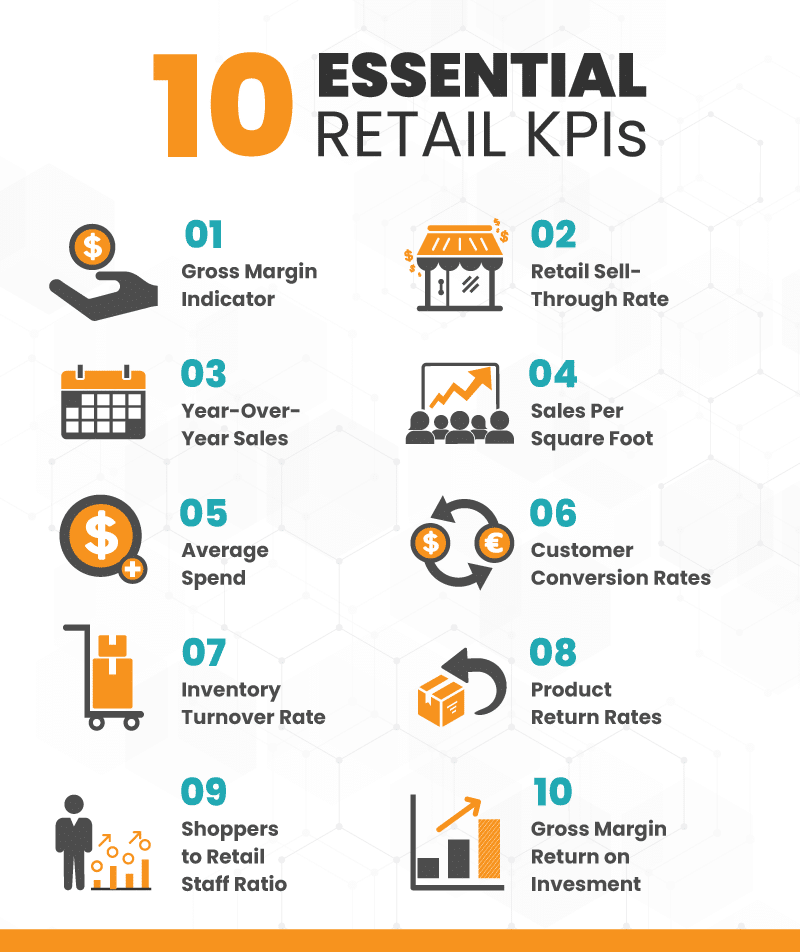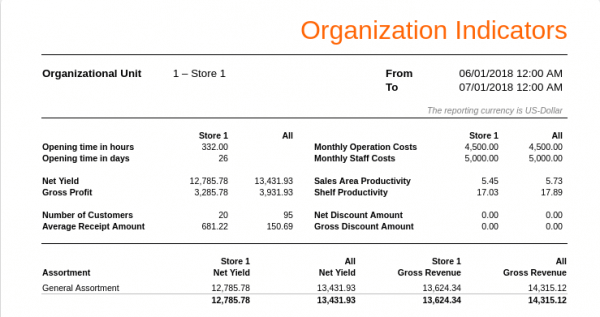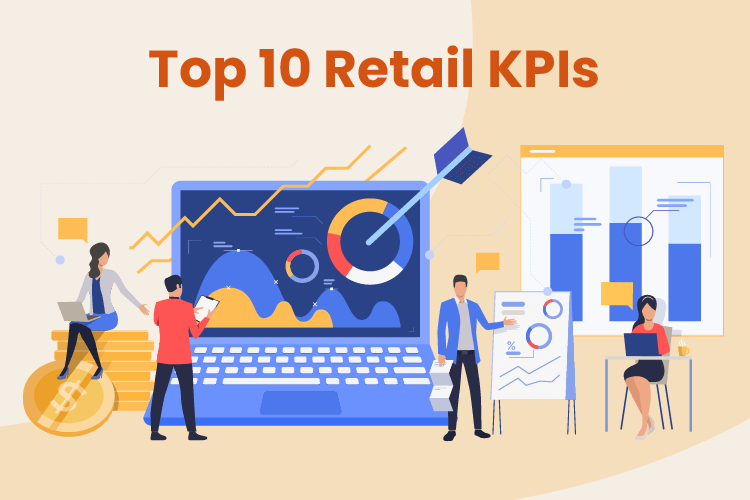The retail industry is one of the most competitive in the world. A successful business must constantly analyze what might make them grow. By keeping up with trends around your niche market, and also considering your business specifically, one must take a holistic approach to improve a company’s performance. These factors are often described as retail key performance indicators or KPIs.
There are hundreds of measurable KPIs but a handful of them are of particular importance across the vast realm of retail. These 10 important retail KPIs will help you understand how your business is performing. You’ll be able to see how certain factors connect and make adjustments to ensure your business is heading in the right direction.
Understanding which KPIs are most important for your business to track is the first step. But you also need the right software to break down your sales and data. Even many small businesses have thousands of transactions and vast inventory counts, making it, at best, unrealistically time-consuming to analyze all of this by hand.
Your retail point of sale software must be capable of presenting this data to you automatically in understandable and digestible ways. So consider each of the retail KPIs listed below and imagine how much easier business operations would be with a POS analytics and reporting that can compute each of these with a click of a button.
10 Retail KPIs for Small Business
- Gross Margin Indicator
- Retail Sell-Through Rate
- Year-Over-Year Sales
- Sales Per Square Foot
- Average Spend
- Customer Conversion Rates
- Inventory Turnover Rate
- Product Return Rates
- Shoppers to Retail Staff Ratio
- Gross Margin Return on Investment

1. Gross Margin Indicator
Most would imagine that gross profit is a more important measure of success. But a company’s gross profit is entirely dependent on the size of the company in question. A major retailer’s gross profit might be 1,000 times that of a local boutique but the boutique could be a much more successful operation.
Gross margin, however, is a more enlightening statistic. This KPI measures gross profit as a percent of gross sales. In other words, it takes the cost of goods sold (COGS) into account.
How it’s useful: It helps determine reasonable markup prices. Adding additional factors into the equation – locations, categories, times – can provide even more insight into a business’s ideal strategy.
2. Retail Sell-Through Rate
A sell-through rate measures the ratio of the number of units sold in a given period and the initial on-hand inventory for the period. It provides the percentage of inventory of a specific product that was sold over a chosen time period.
Divide the total number of a certain item sold by the stock number you had on-hand at the beginning of a given period. Just multiply by 100 to turn the result into a percentage. For instance, if you have 500 items and sell 300, your sell-through rate is 60%. It’s important for you to decide a useful time frame to use when measuring this – this will vary between different business types.
How it’s useful: Such a metric is key for seasonal ordering and marketing. It’s important to order accurately throughout the year, and fluctuating sales by period make this difficult. So, like most KPIs, it’s helpful to have a substantial history for purposes of comparison.
3. Year-Over-Year Sales
Speaking of keeping a history of sales on hand, year-over-year analytics is one of the more basic, but essential retail KPIs. Unfortunately, too many small businesses use this KPI alone. It is much more valuable when coupled with another KPI.
Year-over-year numbers might show that your business grew in a certain area, but it’s crucial to understand exactly why that happened. What products were integral in the growth or decline of your business? Having a more detailed and nuanced understanding will make this much more productive, allowing you to implement useful strategies with your marketing, pricing, and ordering.
How it’s useful: Year-over-year comparisons are great for getting a big picture idea of your business’s performance. Just combine this metric with a few others to make it more revelatory of the health of your business.
4. Sales Per Square Foot
Some retail KPIs give you a perspective on your store layout. First, this determines how efficient your precious space is being used. It’s essential to measure this before and after a retail redesign.
It also is an indicator of staff performance. If you have designated sections of your store and notice large discrepancies between various areas, it might be indicative of poor/great staff performance.
Larger retailers also compare this measurement across different locations in an attempt to identify any cultural or social differences that might impact sales. Your POS makes this process a lot easier with the right solution. The image below shows how KORONA POS breaks down sales by total retail space.
How it’s useful: This can be an indicator of multiple aspects of store performance: retail layout/design, staff productivity, and multi-location analysis.

5. Average Spend
This Retail KPI may be one of the more rewarding to investigate. It encourages business owners to get creative with product placement, store layout, upselling, POS marketing, etc., in order to encourage each customer to spend those couple of extra dollars.
Measuring the average customer transaction value identifies specific target areas, especially when measured against the average number of units purchased. For instance, if your retail store has a high number of units sold but a lower average customer spend, perhaps it would be advantageous to implement product bundles or upsells.
How it’s useful: Measuring average transaction values can help you identify various small areas of improvement to your store. These can add up to noticeable improvements over a longer time period.
6. Customer Conversion Rates
This measure is taken by dividing the total number of transactions by the total number of customers in your shop. It determines the success of some in-store components of your business, such as customer service, store experience, and layout. It’s hard enough to get feet in the door, so you want to make sure you don’t have a low conversion rate. This metric should be evaluated often, especially when there are changes in personnel or merchandising.
Conversions rates are even more important to measure if you have an eCommerce store in addition to brick and mortar.
How it’s useful: Measuring conversion rates and identifying trends is the best metric for determining if you’re offering products that your customers want. This metric gets at the very heart of what your goals should be as a retailer.
7. Inventory Turnover Rate
Simply put, this measures the rate at which a certain product is sold. It’s calculated by measuring the costs of the goods sold and dividing that by the cost of the average amount of inventory on hand. For instance, if your store sold $100 worth of apples and you have an average of $5 worth of apples on hand, your turnover rate would be 20 times per year.
This KPI aids in measuring how often you should be ordering and optimize your stock levels and orders of individual products on your shelves. Ideally, you want similar products to have a similar stock turnover rate. If you have a multi-location operation, this KPI, like many, should be measured against other shops. Detailed POS reports, like the one below from KORONA, do the math for you so you can spend more time on other business operations.
How it’s useful: This metric is most useful for identifying ideal par levels on your inventory. Being short-stocked and over-stocked are equally damaging to most businesses, so getting it right is critical.

8. Product Returns
As straightforward as it sounds, this evaluates the percentages of sales that are returned. A high rate of return could mean that customer service needs to be improved. Or that product design needs to be tweaked to represent better what is being sold. Or simply that your product isn’t all that great 🙁
How it’s useful: Measuring the rates of returned items is a straightforward way of evaluating customer satisfaction. It also may serve as a guide for a smarter return policy. If you have a product that may be bought, used once, and returned (we’ve all been there, right?), change the policy to lower return rates on the item and all similar products.
9. Shoppers to Retail Staff Ratio
This takes the guessing out of strategic staffing. It keeps a content staff while also optimizing your labor costs. This can also be paired with your conversion rate metric to determine when you might be under or overstaffed. If you see a sudden drop in your conversion rate and a high shopper-to-staff ratio, you’ll know that heavier staffing will probably increase sales and is worth the bump in labor costs.
How it’s useful: This is a helpful metric to get a better overall picture of your sales: measure your conversion rates against your labor costs. High labor costs might look bad, but not if they generate more sales. This can give you a more detailed and nuanced perspective on what business operations are generating more sales.
10. Gross Margin Return on Investment
GMROI, for short, tells you how much your profit was based on the amount spent on inventory. So if you sold $100,000 in product and your inventory cost was $50,000, your GMROI would be 2 (you earn $2 for every $1 invested in inventory). This indicator gathers information on both individual products and inventory as a whole. Careful investigation of the GMROI makes it easy to determine which products to push and where to place them in your retail space.
How it’s useful: There are industry standards for GMROI, so this is simple and tangible way of hitting benchmarks. Look up what an optimal GMROI is for your retail niche and let it optimize your inventory and ordering.
Bonus Retail KPIs
Bonus KPI #1: Relative Market Share
Part of growing your business is aiming to acquire a larger portion of the market. To figure out where your business stands in dominating the market, utilize the KPI called relative market share.
First, find out your market share by calculating your company’s total revenue as a percentage of the total revenue your entire industry is generating.
Then you can calculate your relative market share by dividing your percentage share by the percentage share of the largest company.
How it’s useful: Finding out your relative market share compares you to the leading competitor in your industry so you can see how far you are from them. This is not at all about comparing and putting yourself down. Instead, this is about planning out your strategies so that you can push your business to grow.
Bonus KPI #2: Percent of Returning Customers
If you want to understand the overall customer satisfaction with the products you offer and the experience you’re providing, a good KPI to measure is percent of returning customers. Returning customers spend more and are also more likely to recommend your brand to others. So focusing on this metric will play a huge part of your business’s growth.
You can calculate percent of returning customers by dividing your total customers by the number of your returning customers and multiplying it by 100 to get a percentage.
How it’s useful: This will allow you to see how much repeat business you’re getting and how well you are retaining customers. If you have a loyalty program in place, this is also a great indicator of its effectiveness.
Your POS Can Measure and Report Your Retail KPIs
Advanced retail point of sale software like KORONA POS helps retailers analyze important data, like these KPIs and many others. Through customer databases, detailed inventory tracking, smart reporting and much more, your point of sale solution must be the hub of all business operations. Click below to find out more about KORONA.













